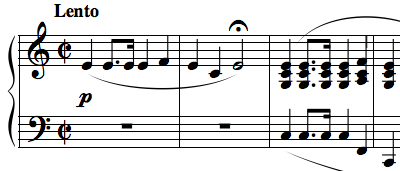
Étude Op. 25, No. 11 (Chopin)
Encyclopedia

A minor
A minor is a minor scale based on A, consisting of the pitches A, B, C, D, E, F, and G. The harmonic minor scale raises the G to G...
, is a solo piano
Piano
The piano is a musical instrument played by means of a keyboard. It is one of the most popular instruments in the world. Widely used in classical and jazz music for solo performances, ensemble use, chamber music and accompaniment, the piano is also very popular as an aid to composing and rehearsal...
technical study composed by Frédéric Chopin
Frédéric Chopin
Frédéric François Chopin was a Polish composer and virtuoso pianist. He is considered one of the great masters of Romantic music and has been called "the poet of the piano"....
in 1836. It was first published together with all études of Opus 25 in 1837, in France, Germany, and England. The first French edition indicates a common time
Common Time
"Common Time" is a science fiction short story written by James Blish. It first appeared in the August 1953 issue of Science Fiction Quarterly and has been reprinted several times: in the 1959 short-story collection Galactic Cluster; in The Testament of Andros ; in The Penguin Science Fiction...
time signature, but the manuscript and the first German edition both feature cut time. The first four bars that characterize the melody were added just before publication at the advice of Charles A. Hoffmann, a friend.
Structure

Dynamics (music)
In music, dynamics normally refers to the volume of a sound or note, but can also refer to every aspect of the execution of a given piece, either stylistic or functional . The term is also applied to the written or printed musical notation used to indicate dynamics...
introduction of the main melody. The first theme
Theme (music)
In music, a theme is the material, usually a recognizable melody, upon which part or all of a composition is based.-Characteristics:A theme may be perceivable as a complete musical expression in itself, separate from the work in which it is found . In contrast to an idea or motif, a theme is...
follows, consisting of tumultuous cascades of semiquaver-tuplets (sixteenth-note-tuplets) and a leaping figure for the left hand in the relative major, C major
C major
C major is a musical major scale based on C, with pitches C, D, E, F, G, A, and B. Its key signature has no flats/sharps.Its relative minor is A minor, and its parallel minor is C minor....
, which shortly segues into a repetition
Repetition (music)
Repetition is important in music, where sounds or sequences are often repeated. One often stated idea is that repetition should be in balance with the initial statements and variations in a piece. It may be called restatement, such as the restatement of a theme...
of the first theme. It finishes with a short development into a fortissimo coda
Coda (music)
Coda is a term used in music in a number of different senses, primarily to designate a passage that brings a piece to an end. Technically, it is an expanded cadence...
, and ends with one final statement of the theme.
Technique
Étude Op. 25, No. 11 is an epic study of right hand dexterity and left hand flexibility. Both hands play an important role throughout the piece; the melody is sung through the heavy left hand, and the right hand contributes the étude's namesake with rapid scales and arpeggios. This study must be navigated with polyphonicPolyphony
In music, polyphony is a texture consisting of two or more independent melodic voices, as opposed to music with just one voice or music with one dominant melodic voice accompanied by chords ....
mindset, treating both hands as separate melodies that work together, in a duet
Duet (music)
A duet is a musical composition for two performers. In classical music, the term is most often used for a composition for two singers or pianists; with other instruments, the word duo is also often used. A piece performed by two pianists performing together on the same piano is referred to as...
for one performer.
One dissertation stresses the importance of implied melodic structure throughout the right-hand figures. Meaning, the following passage (measure 10, 11):

Should be played thus:

accentuating those notes indicated by additional quaver (eighth note) tails. This serves to emphasize the underlying quartal rhythm to further accentuate the march-like theme of the left-hand. Although this analysis may be sound, the performance of this without the aforementioned implications detracts nothing from the rhythmic undulations of the chromatic scales. Abby Whiteside
Abby Whiteside
Abby Whiteside was an influential and controversial American piano teacher. She challenged the finger-centric approach of much classical piano teaching and instead advocated a holistic attitude in which the arm and torso are the conductors of a musical image conceived first in the mind and...
agreed with this subdivision, calling them "tonal patterns which have to be solved before this Etude is playable." Citing her usual procedures of promoting arm strength, she emphasized two key points exemplified by this étude: "notewise procedure does not further bravura playing" and "finger technique is simply not adequate for brilliance and speed." Her dissertation states that this work is impossible without the aforementioned subdivision, and simultaneously advocates her arm technique.

